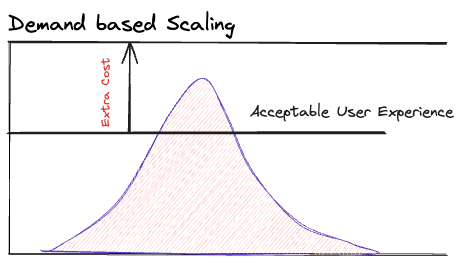Striking a Balance Between Experience and Cost in the Age of Cloud Computing
In a previous article, I explored managing cloud costs from a technological perspective, and based on your feedback, today we’re diving deeper into balancing performance and budget. Many IT professionals have experienced the shift from fixed-capacity infrastructure to cloud-driven architectures. The move to the cloud has brought incredible benefits such as scalability, flexibility, and automation, yet it has also introduced a level of cost unpredictability that did not exist before.
Imagine an e-commerce website on Azure that faces significant traffic surges during peak shopping seasons. To maintain performance, the site must autoscale across various tiers. However, if every layer scales independently without coordination, the result can be uncontrolled cloud expenses. This begs the question: How can we achieve cost efficiency without sacrificing user experience?
Understanding Demand-Based Scaling

The diagram above illustrates the trade-off inherent in demand-based scaling. The horizontal line represents the threshold of “acceptable user experience,” while the bell-shaped curve shows typical demand over time. As demand increases beyond the acceptable threshold, additional resources must be provisioned, incurring extra costs. Ideally, you want to scale enough to preserve user experience during peak loads, yet avoid over-scaling that leads to runaway expenses.
Striking this balance is at the heart of cloud cost management.
On-Premises vs. Cloud: A Cost Management Perspective
Before the advent of cloud computing, managing IT costs was straightforward but inflexible. Organizations procured infrastructure upfront, with budgets designed around fixed-capacity purchases. This approach ensured predictable expenses but came at the cost of agility. IT teams would often plan for peak loads, meaning they had to pay for excess capacity during normal operations. The procurement process involved multiple levels of approval, instilling financial discipline yet making it difficult to scale quickly when unexpected demand occurred.
With the cloud, the paradigm shifted to on-demand scalability and a transformation from capital expenditures (CapEx) to operational expenditures (OpEx). This allowed businesses to scale faster and more dynamically.
However, the ease of scaling also means that if autoscaling is left unchecked—especially when multiple application tiers scale independently—costs can quickly spiral, undermining the benefits of improved performance.
Smart Scaling: Coordinated Autoscaling for Optimal Performance
There is a common misconception that autoscaling automatically resolves performance challenges. In reality, an uncoordinated scaling approach can lead to significant cost spikes. Consider a news website that suddenly experiences a viral surge in traffic. Typically, web servers might scale first, followed by application services, and then databases. Without coordination, this cascading scale-out results in an exponential rise in expenses.
A more effective strategy involves coordinating autoscaling across tiers. For example, web and application layers should work in tandem so that additional resources are introduced only when absolutely necessary. Implementing caching mechanisms such as Azure Front Door or Azure Cache for Redis can alleviate the load on backend services, while database autoscaling should be optimized using tools like Azure SQL Hyperscale or Cosmos DB autoscale. This ensures that compute power is added precisely when needed, rather than as a reflexive response to a traffic surge.
API Cost Management: Taming Request-Driven Expenses
APIs often serve as a hidden driver of cloud costs. Take, for example, a financial services application offering real-time stock tracking. Such an application may process millions of requests per second, which can inadvertently trigger backend resources to scale beyond what is required. This uncontrolled scaling can lead to enormous cloud bills, even if the performance improvements are marginal.
The solution lies in implementing measures to control API usage. Using Azure API Management (APIM) to enforce rate limits ensures that free-tier users or unexpected traffic bursts do not overwhelm the system. Additionally, caching frequently requested API responses helps reduce the strain on backend systems. Adopting quota-based API pricing models further aligns usage with cost, ensuring that the expense grows in proportion to actual demand rather than uncontrolled scaling.
Strategic Workload Placement with Azure Services
Choosing the right Azure service for each workload is a critical element of cost control. When workloads are assigned to services that best fit their usage patterns, businesses avoid over-provisioning and unnecessary expenditure. For example, web applications benefit from the managed hosting environment of Azure App Service, while containerized applications are well-suited for Azure Kubernetes Service (AKS). Event-driven workloads can leverage Azure Functions, where costs are based solely on execution time rather than continuous resource allocation.
Similarly, for data-intensive processes, on-demand solutions like Azure Synapse Analytics or Microsoft Fabric enable payment only for the compute power used at the moment. Storage solutions such as Azure Blob Storage take advantage of tiered pricing, automatically moving infrequently accessed data to lower-cost storage options. These strategic decisions play a pivotal role in preventing cost spirals and ensuring that each workload is both performant and cost-effective.
FinOps: Integrating IT, Finance, and Operations
Managing cloud costs effectively is no longer solely an IT challenge—it requires a harmonious integration of engineering, finance, and business insights. The adoption of FinOps practices has emerged as a robust approach to achieving this balance. By establishing accountability for cloud spending through chargeback or showback models, organizations can ensure that every team understands the financial impact of their resource usage. Tools like Azure Cost Management provide real-time budget thresholds and alerts, enabling proactive adjustments to prevent overspending.
Furthermore, optimizing resource commitments with options like Reserved Instances and Spot VMs can reduce long-term costs, making the overall cloud strategy financially sustainable. This integrated approach transforms cloud cost management into a collaborative effort, aligning technical efficiency with financial prudence.
Continuous Optimization: Cultivating a Cost-Conscious Culture
Effective cloud cost management is an ongoing journey rather than a one-time fix. It requires continuous evaluation of spending patterns, workload placements, and scaling policies. By fostering a culture where cost awareness is part of everyday operations, IT teams can proactively audit expenses and optimize underutilized resources. Emphasizing the use of serverless and managed services, where applicable, further minimizes the need for dedicated VMs and drives cost efficiency. Educating development teams about the financial implications of their architectural decisions ensures that everyone is aligned in the pursuit of sustainable cloud operations.
The Takeaway: Architecting for Experience and Cost Efficiency
Balancing high-performing digital experiences with cost-effective cloud strategies demands a deliberate, strategic approach. Through coordinated autoscaling, intelligent API management, thoughtful workload placement, and robust FinOps practices, organizations can harness the full potential of cloud computing without letting expenses spiral out of control.
Key strategies include:
- Coordinated autoscaling to prevent exponential cost increases
- Controlled API usage to manage request-driven expenses
- Strategic placement of workloads on the most appropriate Azure services
- A collaborative FinOps approach that integrates IT, finance, and business operations
What strategies have helped you optimize cloud costs in your organization? Let’s discuss and learn from each other’s experiences.

